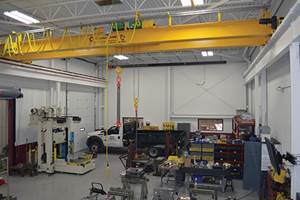The Bottom Line: Recent Tax Issues Affecting Moldmakers
With a top federal income tax rate of almost 40 percent, coupled with other obligations such as payroll taxes, state income taxes and excise taxes, a significant tax burden is placed on moldmakers.
With a top federal income tax rate of almost 40 percent, coupled with other obligations such as payroll taxes, state income taxes and excise taxes, a significant tax burden is placed on moldmakers. To help reduce this burden, I attend trade shows, government meetings and plant tours, which arm me with useful tax information to share with industry.
SPI recently held its annual Plastics Industry Fly-In, an organized series of meetings with members of Congress, during which I met with legislators and tax counsel who could impact tax policy with respect to the plastics and tooling industries. Our discussion topics were quite different this year than in years past.
In prior years, the topic du jour was “tax extenders,” a set of provisions in the tax code that must be renewed regularly. In recent years, Congress has allowed provisions to expire, then retroactively re-enacted more than 50 of them at the end of that year.
The tooling and plastics industries had focused on three main “extenders:” the R&D tax credit, bonus depreciation and Section §179 capital expenditure write-offs. However, the Protecting Americans from Tax Hikes Act of 2015 (PATH), which was passed last December, changed the narrative. The R&D tax credit and §179 were made permanent, and bonus depreciation was extended for five years with an obvious attempt at phasing out the incentive for capital purchases (see February 2016 column).
The PATH’s sweeping changes to tax incentives for the tooling and plastics industries are what changed the discussion at this year’s SPI event. They were forward-thinking and aimed at identifying ways Congress can help the industry and the manufacturing economy as a whole. Here, I will highlight a few of the main discussion points:
Improvements to the R&D tax credit and research expenditure provisions. We explored two different developments that would help tool builders with respect to the R&D tax credit: an increased Alternative Simplified Credit (ASC) and the ability for passive shareholders of flow-through entities to deduct research expenditures in the year paid or incurred for purposes of the Alternative Minimum Tax (AMT).
Inevitably increasing tool builders’ research credit claims, H.R. 5187 (the Research and Experimentation Advances Competiveness at Home Act of 2016) increases the ASC from 14 to 20 percent for tax years beginning after December 31, 2015. If Congressman Pat Tiberi’s bill becomes law, tools builders’ research credit claims could increase by as much as 40 percent.
In addition, we discussed the disincentive for some companies to invest in research and development. This disincentive is not directly related to the R&D tax credit, but associated with the treatment of underlying research expenditures. Investors who do not materially participate (passive investors) in a flow-through entity (S Corporations, partnerships and LLCs) must amortize their research expenditures over 10 years for purposes of the AMT, as opposed to deducting them as they are paid or incurred. Since most companies elect to deduct their research expenditures in the year paid or incurred for regular income tax purposes, this provision of the law puts many passive shareholders in the unfavorable position of paying the AMT. In our experience, this deters numerous family-owned businesses, private-equity-owned companies and venture capital firms from investing in research. Many of those with whom I met were unaware of this provision and seemed open to removing the disincentive.
Recent and forthcoming regulations. The Treasury Depart-ment’s attack on corporate inversions was all the buzz during my visit to Washington. Corporate inversions are a means of large companies reorganizing and moving headquarters overseas in order to obtain a more favorable worldwide tax rate.
While one would think that Treasury’s most recent set of proposed regulations would affect only a few large, corporate taxpayers, this was far from the case. Unfortunately, the Treasury’s most recent effort to curb this shelter allows for the IRS to reclassify debt as equity. The well-meaning Treasury regulations seemed to cause more complexity and confusion than anticipated as well as subject small manufacturers to a mountain of paperwork that was not necessary in the past.
For instance, the new regulations could cause major issues for S Corporations that have foreign debt or close to the maximum number of shareholders allowed, or spur other complex issues. One company likened the new loan documentation requirements to signing a home mortgage every time there was a debt transaction with an owner or other related party. Nevertheless, the Treasury seems intent on forging ahead to finalize the proposed regulations. If changes were to be enacted, they would need to originate in a bi-partisan fashion, as Republicans seem to fear being painted as pro-inversion and Democrats do not want to challenge others in their own party.
Moreover, there seems to be a sense that more Treasury regulations are coming that will affect the industry. Specifically, I spoke with legislators about the proposed regulations related to the domestic production activities deduction, an incentive that U.S. toolmakers use to lower their taxable income (see October 2015 column). Since Congress directed the Treasury to issue regulations to determine which party is performing a qualified production activity, we do not anticipate any interference from the legislative branch. Therefore, we expect the Treasury to finalize these regulations in the coming months.
Tax reform. Just one day after the fly-in ended, the House Committee on Ways and Means released its much-anticipated, initial proposal for tax reform, “A Better Way.” In the 35-page document, the Committee outlined its vision for a reformed tax code to increase gross domestic product, increase wages and add jobs. The proposal slashes the top income tax rates (for both C Corporations and flow-through entities), moves to a territorial system of worldwide taxation, allows for immediate deductions for the purchase of tangible and intangible assets, eliminates most credits except for the R&D tax credit, reduces the top individual income tax rates, and eliminates the estate tax.
The Senate Finance Committee (SFC) has taken a different approach by first attempting to level the playing field with respect to both corporate structure and the means companies generate funding for growth. It accomplishes the former by making a C Corporation more attractive to current flow-through entities. It accomplishes the latter by making both interest and dividends deductible. However, in order to pay for the deductibility of dividend payments, the SFC proposes to eliminate the preferential dividend rate on qualified dividends (currently a top rate of 20 percent, plus the 3.8 percent Obamacare surtax) and institute withholding on both dividend and interest payments.
The SFC proposal may be attractive for tool builders that like keeping the company’s and the owner’s tax bills separate. It also advances the idea that the costs associated with debt and equity should be treated the same in the tax code. However, eliminating the preferential dividend rate may have significant implications for investors and eliminate the permanent tax savings for the interest charge domestic international sales corporation (IC-DISC), which is one tax-planning opportunity used by numerous mold builders (see August 2015 column).
The IC-DISC can reduce the overall income tax associated with U.S. manufacturing. Increasing the tax rate on qualified dividends would make this popular tax planning opportunity all but disappear. By taxing ordinary profits and dividends from an IC-DISC at the same rate, the permanent tax savings opportunity turns into a timing difference (which year a company must recognize the income from the IC-DISC). This concern is now on the SFC’s radar, with hopes the SFC final proposal will keep the GDP-increasing provision a part of the tax law.
Of course, we only scratched the surface with respect to the tax issues coming out of Washington that affect the tooling industry. As new information comes to light, we will report these developments and how they affect your bottom line.
Related Content
Think Safety: Eliminate Hazards Throughout the Shop
The tooling community is taking advantage of new products for safer mold shops and molding facilities.
Read MoreTackling a Mold Designer Shortage
Survey findings reveal a shortage of skilled mold designers and engineers in the moldmaking community, calling for intervention through educational programs and exploration of training alternatives while seeking input from those who have addressed the issue successfully.
Read MoreThe Trifecta of Competitive Toolmaking
Process, technology and people form the foundations of the business philosophy in place at Eifel Mold & Engineering.
Read MoreMaking Quick and Easy Kaizen Work for Your Shop
Within each person is unlimited creative potential to improve shop operations.
Read MoreRead Next
The Bottom Line: A Method to the Tax Madness
Every shop must adopt a method of accounting for activities within its business, and cash and accrual methods are two commonly used ones.
Read MoreReasons to Use Fiber Lasers for Mold Cleaning
Fiber lasers offer a simplicity, speed, control and portability, minimizing mold cleaning risks.
Read MoreHow to Use Continuing Education to Remain Competitive in Moldmaking
Continued training helps moldmakers make tooling decisions and properly use the latest cutting tool to efficiently machine high-quality molds.
Read More


















